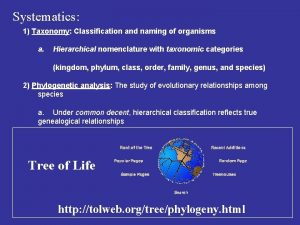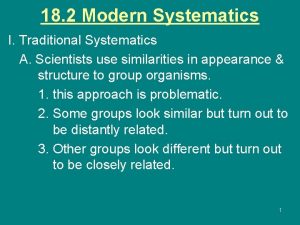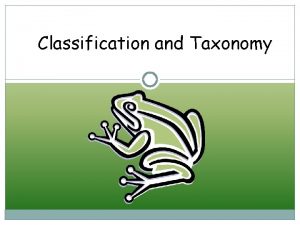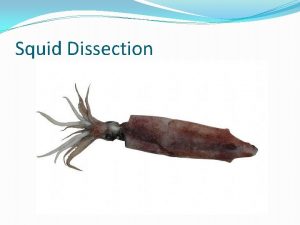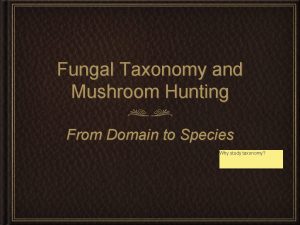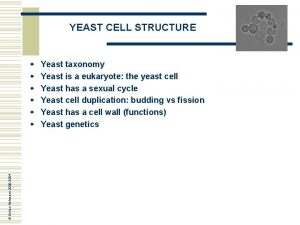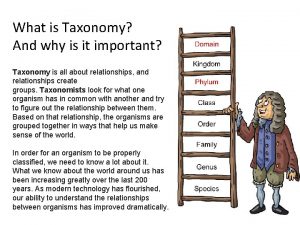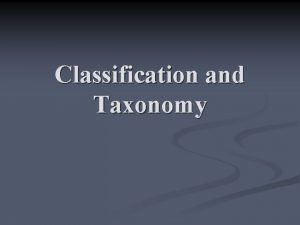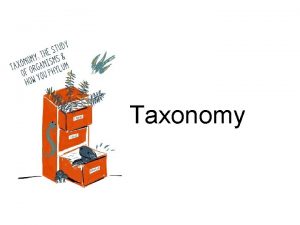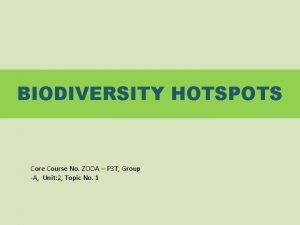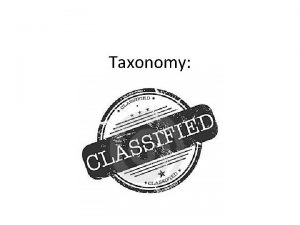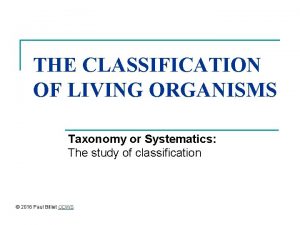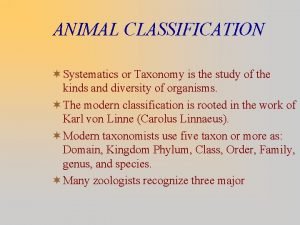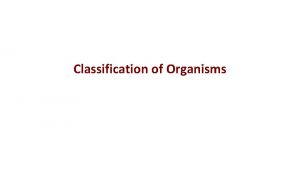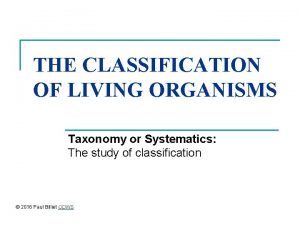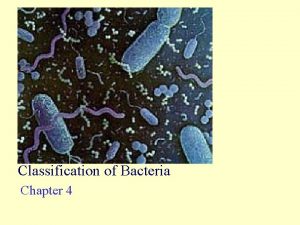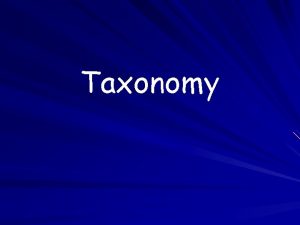Taxonomy Systematics Classification Core Course No ZOOA P





























- Slides: 29

Taxonomy, Systematics & Classification Core Course No. ZOOA – P 11 T, Unit: 1, Topic No. 2

Historical Retrospect � Taxonomy is the branch of biology that names and groups organisms according to their characteristics and evolutionary history. � Organisms were first classified more than 2, 000 years ago by the Greek philosopher Aristotle.

Early System of Classification � Organism’s were grouped into land dwellers, water dwellers, and air dwellers. � Plants were placed into three categories based on the differences in their stems. � As new organism’s were discovered, his system became inadequate. ◦ Categories were not specific enough. ◦ Common names did not describe a species accurately. ◦ Names were long and hard to remember.

Modern System: Hierarchy Seven Levels of Organization � � � Carolus Linnaeus (mid-1700’)s was a Swedish biologist who established a simple system for classifying and naming organisms. He developed a Hierarchy (a ranking system) for classifying organisms that is the Basis for Modern Taxonomy. For this reason, he is considered to be “father” of modern taxonomy.

Modern System a Nested Hierarchy. Seven Levels of Organization � Linnaeus used an organisms morphology (form and structure), to categorize it. � His system is still being used today. � His system allowed organisms to be grouped with similar organisms. � He first divided all organisms into two Kingdoms, Plantae (Plants) & Animalia (animals). � This was the same as Aristotle’s main categories.

Modern System a Nested Hierarchy. Seven Levels of Organization ◦ Each kingdom (plant and animal) was divided into a phylum ◦ Each phylum into a smaller groups called class. ◦ Each class was divided into an order. ◦ Each order was divided into family (families). ◦ Each family was divided into a genus (plural-genera) ◦ Each genus was divided into a species. (scientific name) *Note: Phyla and family were not in Linnaeus’s classification system but were added by modern scientists.

Levels of Classification � Remember: King Philip Came Over For Grandma’s Soup. Kingdom Phylum Class Order Family Genus Species

Classification of Modern Humans

Modern Taxonomists � Taxonomists varieties. split species into subsets called ◦ Zoologists refer to variations of a species that occur in different geographic areas called subspecies. � To classify organisms, modern taxonomist consider the phylogeny (evolutionary history) of the organism.

Taxonomy: Etymology � The word ‘Taxonomy’ derived from two Greek words, ‘taxis’ meaning arrangement & ‘nomos’ meaning law � First proposed by A. P. de Candolle in 1813

Taxonomy: Definition “Taxonomy is theoretical study of classification, including its bases, principles, procedures and rules” (George G Simpson, 1961) “Taxonomy is theory & practice of classifying organisms” (Ernst Walter Mayr, 1982)

Systematics � ‘Systematics’ is originated form the Latinized Greek word ‘systema’ meaning to ‘put together’ � First used by Carl Linnaeus in the 4 th edition of his book Systema Naturae in 1735 Carl von Linné, Alexander Roslin, 1775

Systematics �“ The scientific study of the kinds and diversity of organisms and of any and all relationships among them” (George G Simpson, 1961) � More simply, systematics is “the science of diversity of organisms” � This relationship is to be understood not in the sense of phylogeny but including all biological interactions among organisms

Classification & Nomenclature � “Zoological Classification is the ordering the animals into groups (or sets) on the basis of their relationships or of association by contiguity, similarity or both. ”

Classification & Nomenclature � “Zoological Nomenclature is the application of distinctive names to each of the groups recognized in any given zoological classification”

Place of Systematics in Biology � It determines, by comparison, what the unique properties of every species and higher taxon are � It determines what properties certain taxa have in common to each other and the cause of biological differences or shred characters � Relates variation within the taxa

Contribution of Systematics to Biology 1. 2. 3. 4. 5. 6. 7. 8. 9. Patterned Diversity Applied Biology Epidemiology Biological Control Wildlife Management Environmental Problems Soil Fertility Introducing commercially important species Theoritical Biology

Scope of Taxonomy � Provides vivid picture of Organic diversity � Information � Helps in nomenclature � Delineates � Finds for reconstruction of phylogeny the causes of diversity out economically important species � Nourishes other branches of study

Alpha Taxonomy � Naming Species � Describing undescribed organism � Using multiple descriptions of the same organism

Beta Taxonomy � It refers to the arrangement of the species into a natural system of hierarchical categories � Done on the basis of shred, structural features � Unique diagnostic feature to each taxon

Gamma Taxonomy � Designates the analysis interspecific variations & evolutionary studies � Much attention paid to the casual interpretation of the organic diversity � But in actual practice it is difficult to dissociate them because apart from few groups taxonomy has hardly reached Gamma level

Microtaxonomy & Macrotaxonomy In 1975, Mayer & Ashlock first put forward the concept of Microtaxonomy � It involves the study of concepts of species like Typological Species concept, Nominalistic Species concept, Biological Species concept, Evolutionary Species concept etc.

Microtaxonomy & Macrotaxonomy � Microtaxonomy 1. 2. 3. 4. deals with problems like Evolution of species Estimation of species population in the living world Geographic variation of species Definitions of species & sub species (Mayr, 1957)

Microtaxonomy & Macrotaxonomy � It is the science of classification deals with reconstructing phylogeny � Involves study of homology, analogy, affinities, systematic status etc. � Microtaxonomy & Macrotaxonomy are related in the sense & incomplete without each other because grouping (Macro) is not possible without knowing the features of the object (Micro)

Terms in Taxonomy � Phenon: (camp & Gilly, 1943) The different forms of phenotypes that generally occur within a single population � Taxon: (Simpson, 1961) A named taxonomic group of any rank that is considered sufficiently by taxonomists to be formally recognized & assigned to a definite category (Ex: Rodentia, Mammalia, Chordata etc. )

Terms in Taxonomy 1. Category: It is a class whose members are all taxa that are assigned a given rank. A category thus designates a rank or level in a hierarchical classification (Ex: Family, Order, Genus etc. ) 2. Sibling Species: These are morphologically similar or identical populations that are reproductively isolated

Terms in Taxonomy 3. Sub Species: It is aggregate of phenotypically similar populations of a species, inhabiting in a geographic sub division of the range of a species & differing taxonomically form other populations of the same species 4. Deme: (Glimore & Gregor, 1939) It is a local population of a species, the community of potentially interbreeding individuals at a given locality. Rather this is a group of individual animals of one species or sub species so localized that they are in easy and in frequent contact with each other

Terms in Taxonomy 5. Cline: (Huxley, 1938) It is a character gradient taking place in a contiguous population. (Ex: Geocline, Ecocline, Thermocline etc. ) 6. Monotypic Species: Species that are not subdivided into subspecies 7. Polytypic Species: Species that are subdivided into two or more subspecies

Terms in Taxonomy 8. Allopatric Species: Species normally inhabiting completely different geographical regions 9. Sympatric Species: These are good species occupying the same geographical area 10. Panmictic Species & 11. Apomictic Species
 Systematics vs taxonomy
Systematics vs taxonomy 0110001101
0110001101 Traditional systematics
Traditional systematics Systematics deals with
Systematics deals with Section 2 modern classification
Section 2 modern classification Kendall and marzano
Kendall and marzano Phylogenetic tree grade 11
Phylogenetic tree grade 11 Dog full taxonomy
Dog full taxonomy Classification and dichotomous key
Classification and dichotomous key Equs caballus
Equs caballus Dichotomous key for cars
Dichotomous key for cars External squid anatomy
External squid anatomy Domain taxonomy
Domain taxonomy Inner core and outer core
Inner core and outer core Earth mantle definition
Earth mantle definition Crust outer core inner core mantle
Crust outer core inner core mantle Purpose of paradox
Purpose of paradox Cumulative gpa vs core gpa
Cumulative gpa vs core gpa One and a half brick wall
One and a half brick wall Course title and course number
Course title and course number Course interne moyenne externe
Course interne moyenne externe Eager classification versus lazy classification
Eager classification versus lazy classification Chronological tabulation is based on
Chronological tabulation is based on Traditional classification vs modern classification
Traditional classification vs modern classification Yeast taxonomy
Yeast taxonomy Mnemonic for taxonomy
Mnemonic for taxonomy What is taxonomy and why is it important
What is taxonomy and why is it important Pros and cons of virtualization
Pros and cons of virtualization Mnemonic for taxonomy
Mnemonic for taxonomy Builder vs buyer in stm
Builder vs buyer in stm

